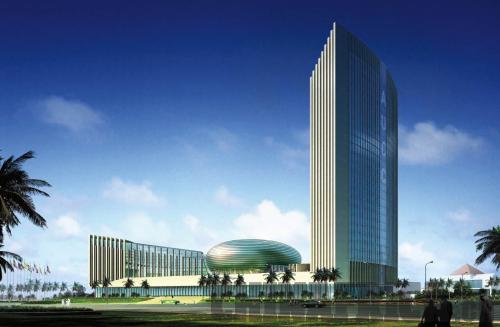| 
The new China constructed African Union (AU) headquarters in Addis Ababa, inaugurated on January 18, was meant to demonstrate China's support for African unity and integration. Instead it has provoked heated debate. In her article "Tragedy of the New AU Headquarters," author and columnist with NewsAfrica London Chika Ezeanya says the building will continue the political and economic manipulation and domination of Africa by foreign powers. In response Antoine Roger Lokongo, a journalist and doctoral candidate at Peking University, and Zhao Changhui, Senior Advisor of the China-Africa Economic and Technological Cooperation Committee, say the building will strengthen Sino-African ties.
Tragedy of the New AU HQ
by Chika Ezeanya
On January 28, 2012, African countries descended to a collective new low on the global index of state sovereignty, territorial integrity and actual independence of nations. On that day, Chinese President Hu Jintao was in Addis Ababa, Ethiopia, to commission the new $124 million AU headquarters (HQ) built and donated to the continent by China. Termed "China's gift to Africa," the edifice was constructed by the China State Construction Engineering Corp. with over 90 percent Chinese labor. It is to the discredit of the AU that in 2012 a building as symbolic as the AU HQ is designed, built and maintained by a foreign country, it does not matter which.
The ancient and modern history of donation of buildings and structures from one nation to another is filled with intrigues and subterfuges, conquests, diplomatic scheming, espionage and counter-espionage, economic manipulations, political statements and dominations. The construction of the Trojan horse by Odysseus and its "donation" resulted in the Greek conquest of the ancient city of Troy after 10 years of unending skirmish.
In a rare glimpse into the matter, the book Architecture of Diplomacy, Jane C. Loeffler reveals the underlying diplomatic maneuverings and political ramifications that define the construction of American embassies all over the world. The author states that building an embassy requires "as much diplomacy as design." Loeffler enumerates factors seriously considered in the construction of an American embassy building and they include "world politics, American agendas, architectural politics, cultural considerations, security" and several others. Common sense dictates that in an era of increasing exploitation of Africa's natural resources by foreign powers including China, the AU, rather than the apparent submission signified by acceptance of the construction of its headquarters by China, should be an organization advocating for fairness in the relationship that exists between the continent and the global powers.
Add this to the logic espoused in Architecture of Diplomacy and one reasonably concludes that it is unacceptable for Africans to accept a building from China that will house what should be the landmark of the continent's achievements and its aspirations for the future. The AU has since deviated from the ideals of its founding fathers when in the 1960s Kwame Nkrumah and other great African leaders sought to establish an organization that would protect the geographical contiguity and territorial integrity of African nations.
While the AU thinks it has gained from China by moving into its new ultra-modern facility, the reality is that the continent has lost tremendously in all matters worthy of reasonable consideration.
(The article has been edited for space and tense and first appeared in pambazuka.org)
|